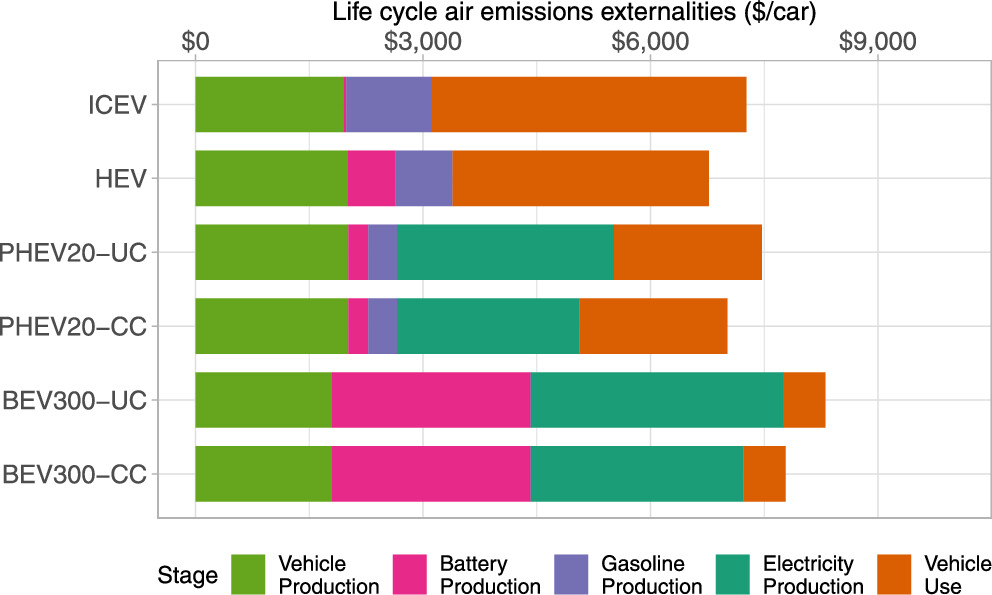I referenced that publication here: A paper addressing the idea that electric cars are "green."
The paper referenced is this one: Cleaning up while Changing Gears: The Role of Battery Design, Fossil Fuel Power Plants, and Vehicle Policy for Reducing Emissions in the Transition to Electric Vehicles Matthew Bruchon, Zihao Lance Chen, and Jeremy Michalek Environmental Science & Technology 2024 58 (8), 3787-3799
A graphic from the full paper is here:

The caption:
Figure 1. Electricity generation mix by region in 2020. Regions other than PJM are ordered from the largest to smallest total regional generation. Generator fuel types are ordered (bottom to top) from the largest to smallest global generation. Generally, PJM has similar properties to most other regions of the world: wind, solar, and nuclear power produce a minority of generation with low marginal cost, typically generating as much energy as possible regardless of the variations in load, while dispatchable fossil fuel plants (primarily coal and natural gas) adjust the generation in response to changes in load. Hydroelectric generation, a small source in PJM, can adjust the timing of generation within constraints (such as lake level limits) (Data from refs (1) and (2)).
Another graphic giving the background for the climate intensity of electric cars is this one:

Figure 6. Consequential life cycle air emission externalities per vehicle in 2019, assuming 10% of the light-duty passenger car fleet in PJM’s service area is replaced with PEVs. “ICEV” denotes a conventional internal combustion engine vehicle, “HEV” denotes a standard gasoline hybrid electric vehicle (NiMH battery), “PHEV20” denotes a plug-in hybrid electric vehicle with a battery range of 20 miles (Li-ion battery with NMC111 cathode chemistry), and “BEV300” denotes a battery electric with a battery range of 300 miles (Li-ion battery with NMC622 cathode chemistry). “CC” indicates that battery charge schedules are optimally controlled by PJM to minimize system operation costs, and “UC” indicates that battery charging is uncontrolled (i.e., initiated by the vehicle owner as soon as they complete their daily driving and arrive home. “Production” includes disposal and recycling; “Vehicle Use” includes tailpipe emissions and tire and brake wear).
Of course, the graphic refers to cars built 6 years ago, 2019, when the average concentration of the dangerous fossil fuel waste on the planet was
411.65 ppm, as opposed to 424.61 in 2024, and thus far, in 2025, from the spreadsheet I keep tracking this data on a weekly basis, 428.27 as of the week beginning 8/17/2025. From what people want me to believe is that over six years, some kind of "renewable energy" heaven has surely broken out "by 2025" although it didn't for all the dates I remember going back to my youth, "by 1980," "by 1990," by 2000," "by 2010," and "by 2020."
Something that sort of troubles me about electric cars, and indeed the car I own and drive myself, a 2024 Camry Hybrid, which replaced the 2023 Camry Hybrid that was totaled in an automobile accident when a kid ran a stop sign in front of me - thus failing to recoup the embodied energy involved in building it - is cobalt slavery.
Elon Musk's African cobalt slaves sort of, um, trouble me, even if it doesn't trouble all the "green" people here talking about how battery breakthroughs will save the day.
According to the paper cited back then and above, on the PJM grid, my hybrid car was in the class of "least carbon intensive" but my personal experience with the totaled car, leads me to doubt that I am personally all that "green." In fact, I'm a hypocrite, if it makes antinukes around here happy, since I drive a car of any type while deploring the car CULTure.
Have a nice evening.
 = new reply since forum marked as read
= new reply since forum marked as read

